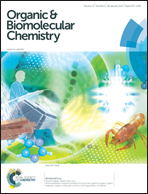Characterizations of cationic γ-carbolines binding with double-stranded DNA by spectroscopic methods and AFM imaging†
Abstract
Two cationic γ-carbolines, 2-methyl-5H-pyrido[4,3-b]indolium iodide (MPII) and 2,5-dimethyl-5H-pyrido[4,3-b]indolium iodide (DPII), were synthesized, and the DNA-binding properties of the cationic γ-carbolines were elucidated. Through a series of experiments, we proved that the two cationic γ-carbolines could strongly interact with DNA by intercalative binding. However, DPII, with a methyl group substituting H atom of 5-NH, has shown a stronger intercalative interaction with DNA compared to MPII. The dissociation of H from the 5-NH of MPII resulted in better water solubility and less binding affinity to DNA. Atomic force microscopy (AFM) images of pBR322 showed that both MPII and DPII strongly interacted with DNA and induced conformational changes in DNA. Moreover, the CT-DNA circular dichroism (CD) spectra changes and the statistics of the node numbers of pBR322 in AFM images indicated that MPII had more profound effects on DNA conformations compared to DPII. Furthermore, our studies have shown that the interactions between cationic γ-carbolines and DNA were sensitive to ionic strength. Increased ionic strength in the buffer caused the DNA helix to shrink, and the base stacking would be more compact, which resulted in minimal intercalation of cationic γ-carbolines into DNA.


 Please wait while we load your content...
Please wait while we load your content...